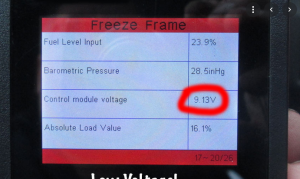What Does Freeze Frame Mean On A Code Reader
When it comes to automotive diagnostics, the term "freeze frame data" often elicits a sense of curiosity among car enthusiasts and everyday drivers alike. Why is this snapshot of vehicle conditions at the moment a trouble code is triggered so critical? Understanding freeze frame data is essential for effective troubleshooting and insights into your vehicle's performance. It enables both novice and seasoned mechanics to diagnose issues swiftly and accurately, ultimately enhancing the longevity and efficacy of the automobile.

At its essence, freeze frame data is akin to a moment captured in time—like the snapshot of your vehicle's operational parameters just before a fault was recorded by the onboard diagnostics (OBD) system. This data provides a plethora of information, including engine RPM, vehicle speed, coolant temperature, fuel pressure, and many other variables present at the critical moment of a diagnostic trouble code (DTC) activation. The richness of this information can transform routine troubleshooting into a meticulous uncovering of underlying issues.
So, what exactly happens when a fault is detected? The OBD system registers the anomaly, and alongside the trouble code, it captures various operational snapshots. This data is then stored temporarily, giving mechanics a clear picture of the vehicle's performance leading up to the fault. It's almost as if the car itself is narrating its story, revealing how conditions affected its operation. The Diagnostic Trouble Codes (DTCs) symbolize the 'what' of the problem, while the freeze frame data reveals the 'when' and 'why.'
Furthermore, recognizing the most critical parameters stored in freeze frame data can be enlightening. For instance, if a trouble code indicates an issue with the oxygen sensor, freeze frame data allows you to see engine load and fuel trims at the moment of the fault. This information can indicate whether the problem occurred under specific driving conditions—perhaps during high acceleration or at idle. Thus, the careful analysis of this data not only addresses the immediate concern but can lead to proactive measures that prevent future issues.
One aspect that many drivers may overlook is the role of ECM (Engine Control Module) in this intricate process. The ECM continuously monitors and records data, enabling it to act like a vigilant guardian of your vehicle's health. When a sensor deviates from its normal operating range, the ECM kicks into action, logging the conditions around that event. This intelligent system nuances the diagnosis, underscoring its importance in modern automotive technology.
Even more fascinating is understanding the varying scenarios under which freeze frame data is generated. Different makes and models may capture different sets of data parameters, based largely on sophisticated algorithms defined by the manufacturers. Thus, knowledge of freeze frame data can differ based on the vehicle in question. This aspect adds a layer of intrigue for automotive enthusiasts who relish the challenge of deciphering the codes across diverse vehicles.
Diving deeper, one might also consider the implications of weather, geographic conditions, and altitude on vehicle performance as revealed through freeze frame data. For example, did the DTC emerge during a cold snap, or was the engine running hot on a balmy summer day? Each of these environmental factors can significantly impact vehicle operations, and freeze frame data can help guide mechanics to address these specific conditions. When troubleshooting, context is everything; thus, understanding these variables through analysis is essential for optimal resolution.
Moreover, freeze frame data plays a significant role in emissions testing and compliance. The data not only assists in identifying faults but also serves as a benchmark against which manufacturers’ standards can be measured. Exhaust systems, engine performance, and emissions controls can all be scrutinized more effectively with the aid of this wealth of information. As regulations continue to tighten around automotive emissions, understanding the relationship between freeze frame data and compliance becomes paramount.
One must also consider the role of advanced diagnostic tools in accessing and interpreting freeze frame data. Modern code readers and diagnostic tools come equipped with sophisticated software that allows for in-depth analysis of this data. As technology evolves, the efficiency and accuracy with which one can diagnose issues become significantly heightened. Many tools even allow users to view freeze frame data graphs, which can help visualize trends and anomalies, thus facilitating quicker diagnostics.
In conclusion, freeze frame data is an indispensable component of automotive diagnostics, revealing critical insights both for immediate troubleshooting and long-term vehicle health. By unraveling the layers of data captured just moments before a fault occurs, drivers and mechanics can cultivate a deeper understanding of their vehicles' intricate systems. The interplay of technology, environmental factors, and human curiosity creates a unique opportunity—as we learn more about our vehicles, we grow closer to mastering the art of automotive care. This commitment to knowledge not only enhances our driving experience but also fosters a greater appreciation for the finely tuned machinery that carries us through our daily lives.
Post a Comment